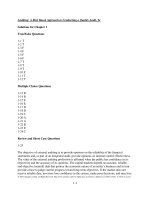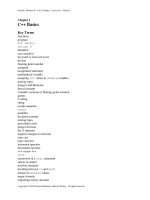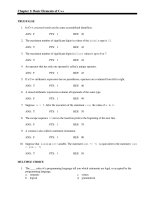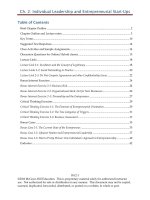Test bank and solution manual introduction to programming WIth c (1)
Bạn đang xem bản rút gọn của tài liệu. Xem và tải ngay bản đầy đủ của tài liệu tại đây (57.57 KB, 14 trang )
Introduction to Programming with C++, Fourth Edition
2-1
Chapter 2
Concept Lesson Questions
1. B analyze the problem
2. B output
3. A input
4. B output
5. B IPO charts
6. A input
7. B entering the input items into the computer
8. C Processing
9. C both what is to be calculated and how to calculate it
10. C entering the input items, then processing the input items, and then displaying,
printing, or storing the output items
11. D pseudocode
12. A Flowcharts
13. C process
14. A input/output
15. D
16. C
17. B
18. C desk-check the algorithm
19. D all of the above
Concept Lesson Exercises
1.
Input
original number
Processing
Processing items: none
Output
squared
value
Algorithm:
1. enter original number
2. calculate the squared value by multiplying the
original number by itself
3. display the squared value
original number
4
6
squared value
16
36
Introduction to Programming with C++, Fourth Edition
2.
Input
state1 sales
state2 sales
commission rate
state1 sales
1000
3000
3.
Input
sales
commission rate
Processing
Processing items: none
Output
commission
Algorithm:
1. enter state1 sales, state2 sales, and commission
rate
2. calculate the total commission by adding the state1
sales to the state2 sales, and then multiplying the
result by the commission rate
3. display the total commission
state2 sales
2000
2500
commission rate
.05
.06
Processing
Processing items: none
start
enter the sales
and commission
rate
calculate the
commission by
multiplying the sales by
the commission rate
display the
commission
stop
commission rate
.1
.06
commission
150
330
Output
commission
Algorithm:
sales
2000
5000
2-2
commission
200
300
Introduction to Programming with C++, Fourth Edition
2-3
4.
Input
region1 sales
region2 sales
region3 sales
region1 increase
region2 increase
region3 increase
Processing
Processing items: none
Algorithm:
1. enter the region1 sales, region2 sales,
region3 sales, region1 increase, region2
increase, and region3 increase
2. calculate the region1 projected sales by
multiplying the region1 sales by the
region1 increase
3. calculate the region2 projected sales by
multiplying the region2 sales by the
region2 increase
4. calculate the region3 projected sales by
multiplying the region3 sales by the
region3 increase
5. display the region1 projected sales,
region2 projected sales, and region3
projected sales
Output
region1 projected sales
region2 projected sales
region3 projected sales
region1 region2 region3 region1 region2 region3 region1
sales
sales
sales
increase increase increase projected
sales
10000 3000
6000
.1
.09
.1
11000
5000
2000
1000
.02
.03
.02
5100
5.
Input
original number
Processing
Processing items: none
region3
projected
sales
6600
1020
Output
squared value
Algorithm:
1. enter original number
2. if the original number is less than or equal to
zero
display an error message
otherwise
calculate the squared value by multiplying
the original number by itself
display the squared value
original number
10
-3
region2
projected
sales
3270
2060
squared value
100
Introduction to Programming with C++, Fourth Edition
6. Results of desk-checking the incorrect algorithm.
beginning inventory amount sold
amount returned
50
10
2
Changes made to the original algorithm are shaded in the IPO chart.
Input
Processing
beginning inventory Processing items: none
amount sold
amount returned
Algorithm:
1. enter the beginning inventory, amount
sold, and amount returned
2. calculate the ending inventory by
subtracting the amount sold from the
beginning inventory, then adding the
amount returned to the result
3. display the ending inventory
Results of desk-checking the correct algorithm.
beginning inventory amount sold
amount returned
50
10
2
2-4
ending inventory
58
Output
ending inventory
ending inventory
42
7. Changes made to the original algorithm are shaded in the IPO chart.
Input
Processing
hours worked Processing items: none
rate of pay
Algorithm:
1. enter the hours worked and rate of pay
2. calculate the gross pay by multiplying the hours
worked by the rate of pay
3. display the gross pay
Output
gross pay
Introduction to Programming with C++, Fourth Edition
Application Lesson Exercises
1.
Input
Processing
room length
Processing items:
room width
room perimeter
ceiling height
wall area
single roll
coverage
Algorithm:
start
enter the room
length, room width,
ceiling height, and
single roll coverage
room perimeter = add together
the room length and room
width, and then multiply the
sum by 2
wall area = room perimeter
multiplied by the ceiling
height
number of single rolls =
divide the wall area by the
single roll coverage
display the
number of
single rolls
stop
2-5
Output
number of single rolls
Introduction to Programming with C++, Fourth Edition
2-6
2.
Input
beginning balance
monthly deposits
monthly withdrawals
Processing
Processing items: none
beginning balance
2000
500
monthly deposits
775
100
3.
Input
first number
second number
third number
first number
25
10
Output
ending balance
Algorithm:
1. enter the beginning balance, monthly
deposits, and monthly withdrawals
2. calculate the ending balance by
adding the monthly deposits to the
beginning balance, and then
subtracting the monthly withdrawals
from the result
3. display the ending balance
monthly withdrawals ending balance
1200
1575
610
-10
Processing
Processing items: none
Output
average
Algorithm:
1. enter the first number, second number, and third number
2. calculate the average by adding together the first number,
second number, and third number, and then dividing the
sum by 3
3. display the average
second number
76
15
third number
33
20
average
44.6666
15
Introduction to Programming with C++, Fourth Edition
4.
Input
original price
discount rate
2-7
Processing
Processing items: none
Output
sales discount
new price
Algorithm:
1. enter original price and discount rate
2. calculate the sales discount by multiplying the original
price by the discount rate
3. calculate the new price by subtracting the sales discount
from the original price
4. display the sales discount and the new price
original price
100
50
discount rate
.25
.1
5.
Input
number of
envelopes
number of pages
charge per envelope
charge per page
sales discount
25
5
new price
75
45
Processing
Processing items:
total envelope charge
total page charge
Output
total due
Algorithm:
1. enter the number of envelopes, number of pages,
charge per envelope, and charge per page
2. calculate the total envelope charge by multiplying
the number of envelopes by the charge per
envelope
3. calculate the total page charge by multiplying the
number of pages by the charge per page
4. calculate the total due by adding the total
envelope charge to the total page charge
5. display the total due
number of
envelopes
number
of pages
charge per
envelope
100
10
100
15
.10
.20
charge
total
per page envelope
charge
.25
10
.30
2
total page
charge
total due
25
4.50
35
6.50
Introduction to Programming with C++, Fourth Edition
6.
Input
first seminar attendees
second seminar
attendees
seminar price
first seminar attendees
10
30
7.
Input
hours worked
hourly pay rate
FWT rate
FICA rate
state rate
hours
worked
20
30
hourly
pay rate
6
10
2-8
Processing
Processing items: none
Algorithm:
1. enter the first seminar attendees, second
seminar attendees, and seminar price
2. calculate the total attendees by adding
together the first seminar attendees and the
second seminar attendees
3. calculate the cost by multiplying the total
attendees by the seminar price
4. display the total attendees and the cost
second seminar attendees seminar price
10
200
10
100
total attendees
20
40
Processing
Processing items: total taxes
Algorithm:
1. enter the hours worked, hourly pay rate, FWT
rate, FICA rate, and state rate
2. calculate the gross pay by multiplying the
hours worked by the hourly pay rate
3. calculate the FWT by multiplying the gross
pay by the FWT rate
4. calculate the FICA by multiplying the gross
pay by the FICA rate
5. calculate the state tax by multiplying the
gross pay by the state rate
6. calculate the total taxes by adding together
the FWT, FICA, and state tax
7. calculate the net pay by subtracting the total
taxes from the gross pay
8. display the gross pay, FWT, FICA, state tax,
and net pay
FWT
rate
.2
.2
FICA
rate
.08
.08
state
rate
.02
.04
total
taxes
36
96
gross
pay
120
300
Output
total
attendees
cost
FWT
FICA
24
60
9.60
24
cost
4000
4000
Output
gross pay
FWT
FICA
state tax
net pay
state
tax
2.40
12
net
pay
84
204
Introduction to Programming with C++, Fourth Edition
8.
Input
side1
side2
side3
side4
Processing
Processing items: none
Output
perimeter
Algorithm:
1. enter side1, side2, side3, and side4
2. calculate the perimeter by adding together
side1, side2, side3, and side4
3. display the perimeter
The desk-check data may vary.
side1
side2
10
6
20
10
9.
Input
diameter
price per foot
2-9
side3
5
15
Processing
Processing items: none
Algorithm:
start
enter the diameter
and price per foot
circumference = diameter
multiplied by pi (3.14)
total price = circumference
multiplied by price per foot
display the
circumference
and price per
foot
stop
side4
8
20
perimeter
29
65
Output
circumference
total price
Introduction to Programming with C++, Fourth Edition
The desk-check data may vary.
diameter
price per foot
35
2
7
3
10.
Input
length in feet
width in feet
price per square foot of
tile
11.
Input
length in feet
width in feet
height in feet
total price
219.80
65.94
Processing
Processing items: none
Output
area
total price
Algorithm:
1. enter the length in feet, width in feet, and
price per square foot of tile
2. calculate the area by multiplying the length
in feet by the width in feet
3. calculate the total price by multiplying the
area by the price per square foot of tile
4. display the area and total price
The desk-check data may vary.
length in feet
width in feet
10
20
circumference
109.90
21.98
2-10
6
10
price per square
foot of tile
5
3
area
total price
60
200
300
600
Processing
Processing items: none
Output
volume
Algorithm:
1. enter the length in feet, width in feet, and height in feet
2. calculate the volume by multiplying the length in feet
by the width in feet, and then multiplying the result by
the height in feet
3. display the volume
The desk-check data may vary.
length in feet
width in feet
100
30
2
3
height in feet
3
4
volume
9000
24
Introduction to Programming with C++, Fourth Edition
12.
Input
current pay1
current pay2
current pay3
raise rate
current
pay1
7.55
8.00
2-11
Processing
Processing items: none
Algorithm:
1. enter the current pay1, current pay2, current pay3, and
raise rate
2. calculate the new pay1 by multiplying the current pay1
by the raise rate, and then adding the result to the
current pay1
3. calculate the new pay2 by multiplying the current pay2
by the raise rate, and then adding the result to the
current pay2
4. calculate the new pay3 by multiplying the current pay3
by the raise rate, and then adding the result to the
current pay3
5. display the new pay1, new pay2, and new pay3
current
pay2
10.00
6.50
current
pay3
10.30
7.25
Output
new pay1
new pay2
new pay3
raise rate
new pay1
new pay2
new pay3
.02
.02
7.70
8.16
10.20
6.63
10.51
7.40
13.
Input
Processing
semester hours
Processing items: none
tuition per semester hour
room and board fee
Algorithm:
start
enter the semester
hours, tuition per
semester hour, and
room and board fee
total cost = multiply the
semester hours by the tuition
per semester hour, and then
add the room and board fee to
the result
display the total
cost
stop
Output
total cost
Introduction to Programming with C++, Fourth Edition
semester hours
20
14
tuition per semester hour
100
100
room and board fee
3000
3000
14.
Input
hours worked
hourly pay rate
Processing
Processing items: overtime pay
2-12
total cost
5000
4400
Output
gross pay
Algorithm:
1. enter the hours worked and hourly pay rate
2. if the hours worked is greater than 40
calculate the overtime pay as follows: first subtract
40 from the hours worked, then multiply the result
by the hourly pay rate divided by 2
calculate the gross pay by multiplying the hours
worked by the hourly pay rate, and then adding the
overtime pay to the result
otherwise
calculate the gross pay by multiplying the hours
worked by the hourly pay rate
3. display the gross pay
hours worked
20
43
hourly pay rate
6
10
overtime pay
45
15. Changes to the original algorithm are shaded in the figure.
gross pay
120
445
Introduction to Programming with C++, Fourth Edition
Input
number
Processing
Processing items: none
Algorithm:
1. enter the number
2. calculate the cube of the number by multiplying
the number by itself three times
3. display the cube of the number
number
4
cube of the number
64
2-13
Output
cube of the number
Introduction to Programming with C++, Fourth Edition
16.
Input
original price
discount rate
Processing
Processing items: none
Output
discount
sale price
Algorithm:
1. enter the original price and the discount rate
2. calculate the discount by multiplying the original
price by the discount rate
3. calculate the sale price by subtracting the discount
from the original price
4. display the discount and the sale price
original
price
100
2-14
discount rate
discount
sale price
.25
25
75









